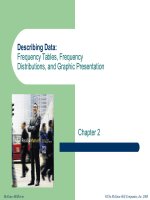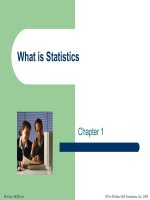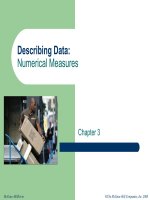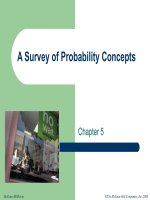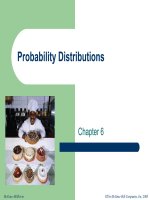Business lecture CHAPTER 9a
Bạn đang xem bản rút gọn của tài liệu. Xem và tải ngay bản đầy đủ của tài liệu tại đây (91.38 KB, 33 trang )
Chapter 9
The Foreign Exchange
Market
9-1
Introduction
Question: What is the foreign exchange market?
Answer:
The foreign exchange market is a market for converting
the currency of one country into that of another country
Question: What is the exchange rate?
Answer:
The exchange rate is the rate at which one currency is
converted into another
9-2
The Functions of the FX Market
Question: What is the purpose of the foreign exchange
market?
Answer:
The foreign exchange market
1. enables the conversion of the currency of one
country into the currency of another
2. provides some insurance against foreign exchange
risk - the adverse consequences of unpredictable
changes in exchange rates
9-3
Currency Conversion
International firms use foreign exchange markets
to convert export receipts, income received from
foreign investments, or income received from
licensing agreements
to pay a foreign company for products or services
to invest spare cash for short terms in money markets
for currency speculation - the short-term movement of
funds from one currency to another in the hopes of
profiting from shifts in exchange rates
9-4
Insuring Against FX Risk
The foreign exchange market can be used to provide
insurance to protect against foreign exchange risk - the
possibility that unpredicted changes in future exchange
rates will have adverse consequences for the firm
a firm that protects itself against foreign exchange
risk is hedging
The market performs this function using
1. spot exchange rates
2. forward exchange rates
3. currency swaps
9-5
Insuring Against FX Risk
1. Spot Exchange Rate - the rate at which a foreign
exchange dealer converts one currency into another
currency on a particular day
determined by the interaction between supply and
demand, and so change continually
9-6
Insuring Against FX Risk
2. Forward Exchange Rates - the exchange rate governing
a forward exchange
A forward exchange occurs when two parties agree to
exchange currency and execute the deal at some
specific date in the future
forward rates are typically quoted for 30, 90, or 180
days into the future
9-7
Insuring Against FX Risk
3. Currency Swap - the simultaneous purchase and sale of
a given amount of foreign exchange for two different
value dates
swaps are used when it is desirable to move out of
one currency into another for a limited period without
incurring foreign exchange rate risk
9-8
The Nature of the FX Market
The foreign exchange market is a global network of
banks, brokers, and foreign exchange dealers connected
by electronic communications systems
The market is always open somewhere in the world
if exchange rates quoted in different markets were not
essentially the same, there would be an opportunity
for arbitrage - the process of buying a currency low
and selling it high
Most transactions involve U.S. dollars on one side
the U.S. dollar is a vehicle currency
9-9
Theories of Exchange Rate Determination
Question: What factors are important to future
exchange rates?
Answer:
Three factors that have an important impact on future
exchange rate movements are
1. a country’s price inflation
2. a country’s interest rate
3. market psychology
9-10
Prices and Exchange Rates
Question: How are prices related to exchange rate
movements?
Answer:
To understand how prices and exchange rates are
linked, we need to understand the law of one price, and
the theory of purchasing power parity
9-11
Prices and Exchange Rates
The law of one price - in competitive markets free of
transportation costs and barriers to trade, identical
products sold in different countries sell for the same price
when their price is expressed in terms of the same
currency
Purchasing power parity theory - given relatively efficient
markets (markets in which few impediments to
international trade and investment exist) the price of a
“basket of goods” should be roughly equivalent in each
country
9-12
Prices and Exchange Rates
PPP predicts that changes in relative prices will result in
changes in exchange rates
when inflation is relatively high, a currency should
depreciate
So, if we can predict inflation rates, we can predict how a
currency’s value might change
the growth of a country’s money supply determines its
likely future inflation rate
9-13
Prices and Exchange Rates
Question: How well does PPP theory work?
Answer:
Empirical testing of the PPP theory indicates that it is not
completely accurate in estimating exchange rate
changes in the short run, but is relatively accurate in the
long run
9-14
Interest Rates and Exchange Rates
Question: How do interest rates affect exchange rates?
Answer:
The Fisher Effect states that a country’s nominal interest
rate (i) is the sum of the real rate of interest (r ) and the
expected rate of inflation over the period for which the
funds are to be lent (l )
in other words, i = r + I
So, if the real interest rate is the same everywhere, any
difference in interest rates between countries reflects
differing expectations about inflation rates
9-15
Investor Psychology and Bandwagon Effect
Question: How are exchange rates influences by
investor psychology?
Answer:
The bandwagon effect occurs when expectations on the
part of traders turn into self-fulfilling prophecies, and
traders join the bandwagon and move exchange rates
based on group expectations
governmental intervention can prevent the
bandwagon from starting, but is not always effective
9-16
Summary
Relative monetary growth, relative inflation rates, and
nominal interest rate differentials are all moderately good
predictors of long-run changes in exchange rates, but
poor predictors of short term changes
So, international businesses should pay attention to
countries’ differing monetary growth, inflation, and
interest rates
9-17
Exchange Rate Forecasting
Question: Should companies invest in exchange rate
forecasting services to help with decision-making?
Answer:
The efficient market school - forward exchange rates are
the best predictors of future spot exchange rates
investing in forecasting services is a waste of money
The inefficient market school - companies should invest
in forecasting services
forward rates are not the best predictor of future spot
rates
9-18
The Efficient Market School
An efficient market - one in which prices reflect all
available information
if the foreign exchange market is efficient, forward
exchange rates should be unbiased predictors of
future spot rates
Most empirical tests confirm the efficient market
hypothesis suggesting that companies should not waste
their money on forecasting services, but some recent
studies have challenged the theory
9-19
The Inefficient Market School
An inefficient market - one in which prices do not reflect
all available information
in an inefficient market, forward exchange rates are
not the best predictors of future spot exchange rates
and it may be worthwhile for international businesses
to invest in forecasting services
However, the track record of forecasting services is
questionable
9-20
Approaches to Forecasting
Question: How should exchange rate forecasts be
prepared?
Answer:
There are two approaches to exchange rate
forecasting
1. fundamental analysis
2. technical analysis
9-21
Approaches to Forecasting
1. Fundamental Analysis - draws upon economic factors
like interest rates, monetary policy, inflation rates, or
balance of payments information to predict exchange
rates
2. Technical Analysis - focuses on trends and believes that
past trends and waves are reasonable predictors of
future trends and waves
9-22
Currency Convertibility
Question: Are all currencies freely convertible?
Answer:
A currency is freely convertible when both residents and
non-residents can purchase unlimited amounts of foreign
currency with the domestic currency
A currency is externally convertible when only nonresidents can convert their holdings of domestic currency
into a foreign currency
A currency is nonconvertible when both residents and
non-residents are prohibited from converting their
holdings of domestic currency into a foreign currency
9-23
Currency Convertibility
Question: Why do countries limit currency convertibility?
Answer:
The main reason to limit convertibility is to preserve
foreign exchange reserves and prevent capital flight when residents and nonresidents rush to convert their
holdings of domestic currency into a foreign currency
In the case of a nonconvertible currency, firms may turn
to countertrade (barter like agreements by which goods
and services can be traded for other goods and services)
to facilitate international trade
9-24
Implications for Managers
Question: What does the foreign exchange market
mean for international firms?
Answer:
Firms must understand the influence of exchange rates
on the profitability of trade and investment deals
This exchange rate risk can be divided into
1. Transaction exposure
2. Translation exposure
3. Economic exposure
9-25




